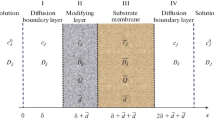Summary
Transport of protons and halide ions through planar lipid bilayers made from egg lecithin and a long-chain secondary amine (n-lauryl [trialkylmethyl] amine) inn-decane was studied. Net proton fluxes were measured with a pH electrode, and halide fluxes were measured with82Br− and36Cl−. In membranes containing the secondary amine, a large net proton flux was produced either by a Br− gradient with symmetrical pH or by a pH gradient with symmetrical Br−, but not by a pH gradient in Br−-free solutions. This H+ flux was electrically silent (nonconductive), and the H+ permeability coefficient was >10−3 cm sec−1 in 0.1m NaBr. In Br−-free solutions, H+ selectivity was observed electrically by measuring conductances and zero-current potentials generated by H+ activity gradients. The permeability coefficient for this ionic (conductive) H+ flux was about 10−5 cm sec−1, several orders of magnitude smaller than the H+ permeability of the electroneutral pathway. Large electroneutral Br− exchange fluxes occurred under symmetrical conditions, and the permeability coefficient for Br− exchange was about 10−3 cm sec−1 at pH 5. The one-way Br− flux was inhibited by substituting SO =4 for Br− on the “trans” side of the membrane. These results support a “titratable carrier” model in which the secondary amine exists in three forms (C, CH+ and CHBr). Protons can cross the membrane either as CHBr (nonconductive) or as CH+ (conductive), whereas Br− crosses the membrane primarily as CHBr (nonconductive). In addition to these three types of transport, there is also a pH-dependent conductive flux of Br− which has a permeability coefficient of about 10−7 cm sec−1 at pH 5. Experiments with lipid monolayers suggest that the pH dependence of this conductive flux is caused by a change in surface potential of about +100 mV between pH 9.5 and 5.0.
Similar content being viewed by others
References
Andreoli, T.E., Bangham, J.A., Tosteson, D.C. 1967. The formation and properties of thin lipid membranes from HK and LK sheep red cell lipids.J. Gen. Physiol. 50:1729
Bangham, A.D., Flemans, R., Heard, D.H., Seaman, G.V.F. 1958. An apparatus for microelectrophoresis of small particles.Nature (London) 182:642
Eisenman, G. 1969. Theory of membrane electrode potentials: An examination of the parameters determining the selectivity of solid and liquid ion exchangers and of neutral ion sequestering molecules.In: Ion Selective Electrodes. R.A. Durst, editor. pp. 1–56. National Bureau of Standards, Washington
Funder, J., Wieth, J.O. 1976. Chloride transport in human erythrocytes and ghosts: A quantitative comparison.J. Physiol. (London) 262:679
Gunn, R.B. 1972. A titratable carrier model for both mono- and divalent anion transport in human red blood cells.In: Oxygen Affinity of Hemoglobin and Red Cell Acid-Base Status. M. Rørth and P. Astrup, editors. pp. 823–827. Munksgaard, Copenhagen
Gunn, R.B. 1978. Considerations of the titratable carrier model for sulfate transport in human red blood cells.In: Membrane Transport Processes. J.F. Hoffman, editor. pp. 61–77. Raven Press, New York
Gutknecht, J., Graves, J.J., Tosteson, D.C. 1978. Electrically silent anion transport through lipid bilayer membranes containing a long-chain secondary amine.J. Gen. Physiol. 71:269
Gutknecht, J., Tosteson, D.C. 1970. Ionic permeability of thin lipid membranes: Effects ofn-alkyl alcohols, polyvalent cations, and a secondary amine.J. Gen. Physiol. 55:359
Gutknecht, J., Tosteson, D.C. 1973. Diffusion of weak acids across lipid bilayer membranes: Effects of chemical reactions in the unstirred layers.Science 182:1258
Hodgkin, A.L. 1951. The ionic basis of electrical activity in nerve and muscle.Biol. Rev. 26:339
Hunter, M.J. 1976. Human erythrocyte anion permeabilities measured under conditions of net charge transfer.J. Physiol (London) 268:35
Jennings, M.L. 1976. Proton fluxes associated with erythrocyte membrane anion exchange.J. Membrane Biol. 28:187
Knauf, P.A., Fuhrmann, G.F., Rothstein, S., Rothstein, A. 1977. The relationship between anion exchange and net anion flow across the human red blood cell membrane.J. Gen. Physiol. 69:363
Lauger, P. 1972. Carrier-mediated ion transport.Science 178:24
McLaughlin, S. 1977. Electrostatic potentials at membrane-solution interfaces.Curr. Top. Membr. Transp. 9:71
Mueller, P., Rudin, D.O. 1969. Translocators in bimolecular lipid membranes: Their role in dissipative and conservative bioenergy transductions.Curr. Top. Bioenerg. 3:157
Sachs, G., Spenney, J.G., Lewin, M. 1978. H+ transport: Regulation and mechanism in gastric mucosa and membrane vesicles.Physiol. Rev. 58:106
Schultz, S. 1977. Sodium coupled solute transport by small intestine: A status report.Am. J. Physiol. 233:E249
Shean, G.M., Sollner, K. 1966. Carrier mechanisms in the movement of ions across porous and liquid ion exchanger membranes.Ann. N.Y. Acad. Sci. 137:759
Tosteson, D.C. 1959. Halide transport in red blood cells.Acta Physiol. Scand. 46:19
Wieth, J.O. 1972. The selective ionic permeability of the red cell membrane.In: Oxygen Affinity of Hemoglobin and Red Cell Acid-Base Status. M. Rørth and P. Astrup, editors. pp. 265–278. Munksgaard, Copenhagen
Wright, E.M., Diamond, J.M. 1977. Anion selectivity in biological systems.Physiol. Rev. 57:109
Author information
Authors and Affiliations
Rights and permissions
About this article
Cite this article
Gutknecht, J., Walter, A. Coupled transport of protons and anions through lipid bilayer membranes containing a long-chain secondary amine. J. Membrain Biol. 47, 59–76 (1979). https://doi.org/10.1007/BF01869047
Received:
Revised:
Issue Date:
DOI: https://doi.org/10.1007/BF01869047




